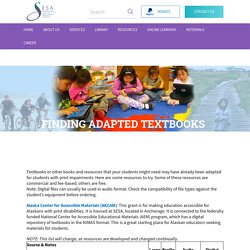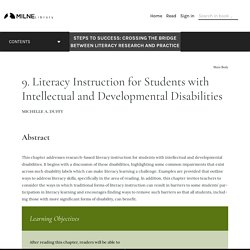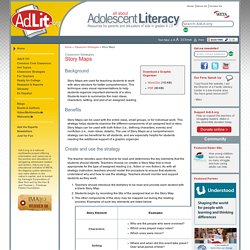

Understand what you read. Learn words with Rewordify.com.

Rewordify.com simplifies difficult English. Enter hard sentences (or whole chapters) into the yellow box at the top of the page. (You can also enter a web site URL.) Click Rewordify text and you'll instantly see an easier version, for fast understanding. The reworded words are highlighted— click them to hear and learn the original harder word. Tier 2 AND Tier 3 Common Core Volcabulary Terms. Finding Adapted Textbooks and Other Reading Materials.
Hi!

My name is Kelsey, this is my sign name. Power Point E-Books. 9. Literacy Instruction for Students with Intellectual and Developmental Disabilities – Steps to Success: Crossing the Bridge Between Literacy Research and Practice. This chapter addresses research-based literacy instruction for students with intellectual and developmental disabilities.

It begins with a discussion of these disabilities, highlighting some common impairments that exist across such disability labels which can make literacy learning a challenge. Examples are provided that outline ways to address literacy skills, specifically in the area of reading. In addition, this chapter invites teachers to consider the ways in which traditional forms of literacy instruction can result in barriers to some students’ participation in literacy learning and encourages finding ways to remove such barriers so that all students, including those with more significant forms of disability, can benefit. Learning Objectives. Making Books Accessible Physical and Electronic Adaptations (2)
Creating Adapted Books Using Google Tools Step by Step Directions. Understand what you read. Adapting Books to Increase Accessibility. When you remember a favorite book or story from childhood, chances are you remember it as a multisensory experience.

Do you recall feelings, images, sounds and even smells that are part of those memories? Maybe a song or activity takes you right back to time spent with a parent, grandparent or teacher and a book or story you shared. You might recall hearing or reading a story that evoked a certain emotion. Books can ignite imagination, provide an escape from the pressures of reality and help us learn. The act of reading to a child can foster a strong emotional bond between adult and child. Yet, for some children the experience of reading a book or even being read to is not memorable, enjoyable or even easily attained. We remember and learn things more effectively when there is a multisensory element attached.
Dyslexia Help for Children and Adults with. Seven Strategies to Teach Students Text Comprehension. 1.

Monitoring comprehension Students who are good at monitoring their comprehension know when they understand what they read and when they do not. They have strategies to "fix" problems in their understanding as the problems arise. Research shows that instruction, even in the early grades, can help students become better at monitoring their comprehension. Monitoring/Clarifying. Inferential Reading. Classroom Strategies Background Teaching students to "read inferentially" helps them learn how to read more strategically.

This technique is derived from the teaching model that learners develop knowledge via the process of interpreting new information in light of past experiences and rethinking past knowledge based on new information. Benefits Inferences are the conclusions we draw based on what one already knows and judgments we make based on given information. Understand the intonation of characters' words and relationships to one anotherprovide explanations for ideas that are presented in the text offer details for events or their own explanations of the events recognize the author's view of the world including the author's biasesoffer conclusions from facts presented in the text relate what is happening in the text to their own knowledge of the world Create and use the strategy Teachers should begin by reading the assigned passage before presenting it to students.
Sample prompts Example: Summarizing. Question-Answer Relationship (QAR) Classroom Strategies Background Question-Answer relationship (QAR) is a strategy to be used after students have read.

QAR teaches students how to decipher what types of questions they are being asked and where to find the answers to them. Four types of questions are examined in the QAR. They include: Right There Questions: Literal questions whose answers can be found in the text. Benefits. VisualizingGraphicOrganizer.pdf. Story Maps. Classroom Strategies Download a Graphic Organizer.

Anticipation Guides. Classroom Strategies Download a Graphic Organizer Blank Anticipation Guide.

OneLook Dictionary Search. 5 Google Tools to Support All Levels of Reading. Reading is multidimensional: it entails decoding of each sound, reading those sounds at an appropriate pace (fluency), then knowing how to interpret each of those word parts in order (morphology and syntax) to understand what you have read (comprehension).

Beyond that, it requires you to bring in prior knowledge, to make connections, make inferences, and revise your mental picture. Students can experience difficulty with any of these stages of reading, thus differentiation is essential to support students with diverse skills and needs. Even schools that are not fully integrated with Google Apps for Education (GAFE) can incorporate these useful tools as they are free, and can be accessed on a teacher’s account, or a single, class account. Below are 5 Google Tools to Support all levels of reading, regardless of skill level or age. 1. Google Docs are a one-stop shop for writing, so how can it support reading? 2. How to Implement Think-Aloud Strategies in Your Class. Use this collection of guidelines, checklists, and assessment tools from Jeff Wilhelm's book Improving Comprehension With Think-Aloud Strategies to start using think-aloud strategies with your students.
Getting Started There are several strategies, called general reading processes, which researchers have discovered readers use every time they read anything. If your students don't do these things, this is the place to start your think-aloud modeling since these strategies will have the greatest pay-off for them across all reading tasks.